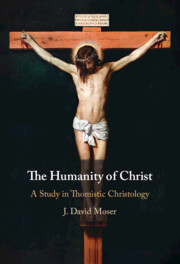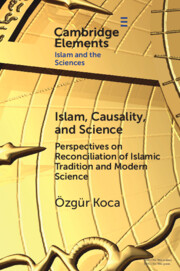Refine search
Actions for selected content:
184 results
Chapter 9 - Suárez on the Influx or Causality of the Final Cause
- from Part III - Causation
-
-
- Book:
- Suárez's <i>Metaphysical Disputations</i>
- Published online:
- 13 October 2025
- Print publication:
- 30 October 2025, pp 162-180
-
- Chapter
- Export citation
Chapter 8 - Motio Metaphorica
- from Part III - Causation
-
-
- Book:
- Suárez's <i>Metaphysical Disputations</i>
- Published online:
- 13 October 2025
- Print publication:
- 30 October 2025, pp 145-161
-
- Chapter
- Export citation
1 - Introduction
-
- Book:
- Multivariable Analysis
- Published online:
- 09 October 2025
- Print publication:
- 23 October 2025, pp 1-13
-
- Chapter
- Export citation
Chapter 10 - Theory of Demonstration
-
-
- Book:
- Ockham’s <i>Summa Logicae</i>
- Published online:
- 04 September 2025
- Print publication:
- 18 September 2025, pp 210-230
-
- Chapter
- Export citation
6 - Toward a More Precise Thomistic Account of the Instrument Doctrine
- from Part II - Difficulties and Resolutions
-
- Book:
- The Humanity of Christ as Instrument of Salvation
- Published online:
- 21 August 2025
- Print publication:
- 04 September 2025, pp 173-198
-
- Chapter
- Export citation
5 - Dubia, Part 2
- from Part II - Difficulties and Resolutions
-
- Book:
- The Humanity of Christ as Instrument of Salvation
- Published online:
- 21 August 2025
- Print publication:
- 04 September 2025, pp 151-172
-
- Chapter
- Export citation

The Humanity of Christ as Instrument of Salvation
- A Study in Thomistic Christology
-
- Published online:
- 21 August 2025
- Print publication:
- 04 September 2025
Chapter 14 - Integration
- from Part V - Integration and Conclusion
-
- Book:
- The Development and Organization of Meaning
- Published online:
- 11 June 2025
- Print publication:
- 26 June 2025, pp 187-200
-
- Chapter
- Export citation
Chapter 6 - The Preschooler
- from Part II - The Growth of Meaning
-
- Book:
- The Development and Organization of Meaning
- Published online:
- 11 June 2025
- Print publication:
- 26 June 2025, pp 67-84
-
- Chapter
- Export citation
Chapter 6 - Perception as a Discriminative Activity
-
- Book:
- Aristotle on the Nature and Causes of Perception
- Published online:
- 01 May 2025
- Print publication:
- 22 May 2025, pp 165-197
-
- Chapter
-
- You have access
- Open access
- HTML
- Export citation
Causal temporal reasoning for Markov decision processes
-
- Journal:
- Research Directions: Cyber-Physical Systems / Volume 3 / 2025
- Published online by Cambridge University Press:
- 10 February 2025, e3
-
- Article
-
- You have access
- Open access
- HTML
- Export citation
7 - Multivariate Linear Time Series
-
- Book:
- Time Series for Economics and Finance
- Published online:
- 19 December 2024
- Print publication:
- 19 December 2024, pp 196-237
-
- Chapter
- Export citation

Islam, Causality, and Science
- Perspectives on Reconciliation of Islamic Tradition and Modern Science
-
- Published online:
- 29 November 2024
- Print publication:
- 19 December 2024
-
- Element
- Export citation
1 - Ethical Guidelines
-
- Book:
- Ethics in Econometrics
- Published online:
- 14 November 2024
- Print publication:
- 28 November 2024, pp 11-33
-
- Chapter
- Export citation
10 - Bivariate Correlation
-
- Book:
- Social Behavioral Statistics
- Published online:
- 13 January 2025
- Print publication:
- 28 November 2024, pp 293-330
-
- Chapter
- Export citation
15 - The Natural-Philosophical Foundations of Quantum Mechanics (Excerpt)
-
- Book:
- The Einstein Paradox
- Published online:
- 14 November 2024
- Print publication:
- 28 November 2024, pp 235-243
-
- Chapter
- Export citation
1 - Explanation
- from Part I - Forms of Inquiry and Argumentation
-
-
- Book:
- Rethinking Global History
- Published online:
- 14 November 2024
- Print publication:
- 21 November 2024, pp 23-46
-
- Chapter
-
- You have access
- Open access
- HTML
- Export citation
4 - Experiments and Causality
- from Part I - The Philosophy and Methodology of Experimentation in Sociology
-
- Book:
- Experimental Sociology
- Published online:
- 23 November 2024
- Print publication:
- 21 November 2024, pp 40-51
-
- Chapter
- Export citation
10 - Validity
- from Part III - Methodological Challenges of Experimentation in Sociology
-
- Book:
- Experimental Sociology
- Published online:
- 23 November 2024
- Print publication:
- 21 November 2024, pp 119-131
-
- Chapter
- Export citation
Engaging Jeffrey Koperski’s decretalism: is occasionalism really avoidable?
-
- Journal:
- Religious Studies , First View
- Published online by Cambridge University Press:
- 13 November 2024, pp. 1-13
-
- Article
-
- You have access
- Open access
- HTML
- Export citation
